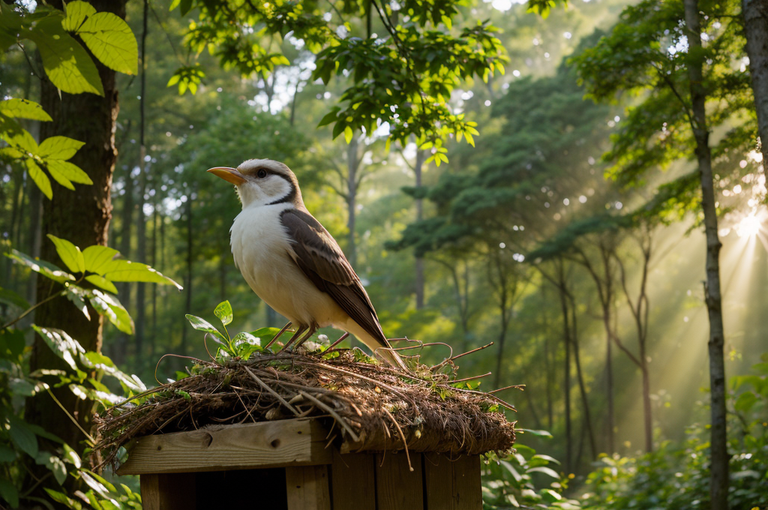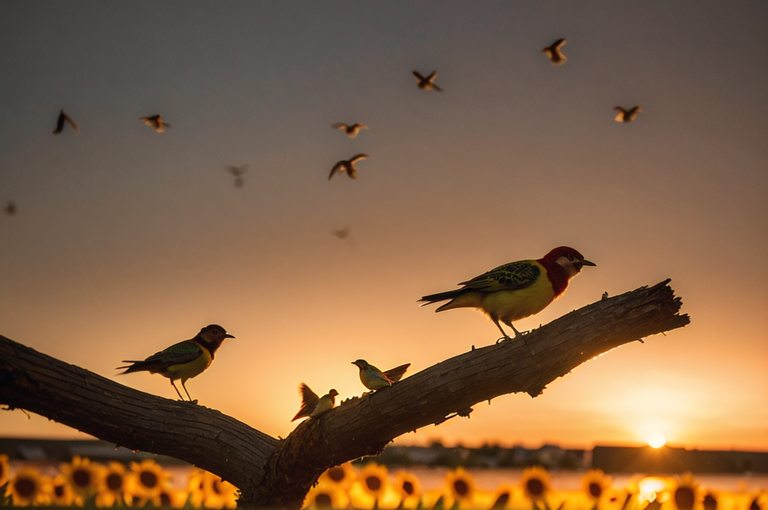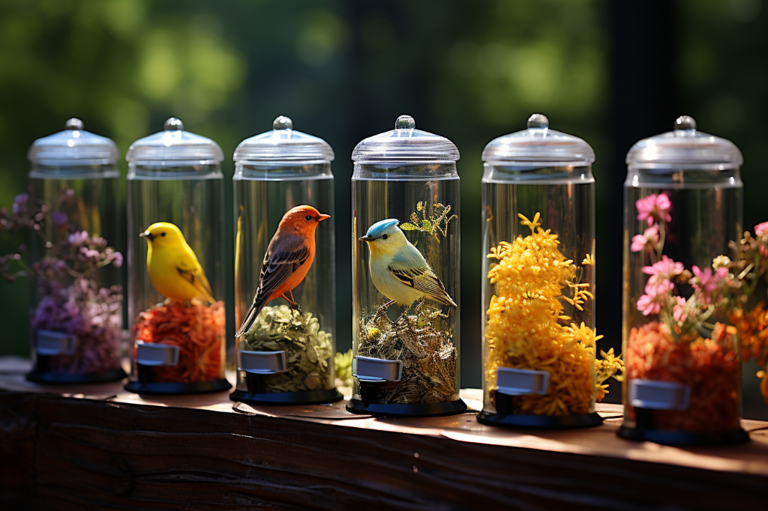Choosing the Right Bird Seeds: Attract More Birds and Minimize Waste

The article provides a detailed analysis of bird seeds, their efficacy in attracting birds, and nutritional value. It highlights sunflower seeds, peanuts, and homemade mixes as top choices.
Understanding Commercial Bird Seed Mixes
Description and Features
With the rising sun and the sweet melody of chirping, I commence my day immersed in the study of our avian friends. Among the many aspects that intrigue me, understanding commercial bird seed mixes stands out significantly. For many of us who are wild about birds, commercial bird seed mixes are a convenient way to cater to our backyard buddies. They’re readily available, providing a mix of various seeds packaged into one, easy to use product.
Issues with Commercial Mixes
However, don’t be fooled by the convenience. My careful observations and rigorous notes have shown that these mixes often come with their unique issues. The primary concern being the presence of ‘filler seeds’ like milo and wheat. Through my analytical lenses, I’ve observed that these filler seeds are largely ignored by birds. This leads to a high level of waste, which isn’t ideal for our pocket or the environment.
Filler Seeds in Commercial Mixes
Take a closer look at those filler seeds, and you’ll begin to understand their role in the grand scheme of things. These seeds are cheap, and while they make the mixes appear fuller and more substantial, they add very little value for our feathered friends. From the purple martins in your backyard to the majestic eagles of Alaska, none are particularly fond of filler seeds. They remain untouched, discarded, leaving a puzzle to solve for those of us who wish to provide an enriching diet for our backyard bird communities.
So then, what should feed our curiosity and our birds’ appetites alike? A seed mix that is appropriate for our avian visitors, affordable for us, and above all, respectful to nature. This quest takes us away from commercial mixes and towards more natural, sustainable alternatives that would definitely see us closer to the magic of wild birds. It is indeed a pursuit that blends scientific curiosity and a growing awareness for what truly benefits our fine feathered friends.

Alternatives to Commercial Bird Seed Mixes
Introduction to Homemade Bird Seed Mixes
Nestled amidst my usual morning bird watch, I’ve often pondered: Can our feathered friends have a feast that didn’t come pre packaged in plastic? Could the best food for wild birds come, not from a pouch, but be homemade? My inquisitive naturalist itch nudged me to experiment with homemade bird seed mixes. 🥣 ✔️
Ingredients of Homemade Bird Seed Mixes
Essential to my homemade mixes are ingredients absent of any fillers. My principle is to create a nutritious banquet that would attract a greater variety of birds while reducing waste. The mixture comprised of seeds like Sunflower, millet, and flax, along with a surprise addition of DIY seed blocks. These robust blocks, concocted from gelatin and corn syrup, contribute much needed proteins and sugars. A palette of nutritional variety that the birds around my garden seemed to relish!🐦🥗 💕
Advantage of Homemade Mixes over Commercial Mixes
Through this, I discovered the distinct edge homemade mixes have over their commercial counterparts. Fresh seeds mean better nutritional value, a clear winner over preservative laden commercial mixes. The lack of fillers means there’s less waste. And oh, what fun it is to see your backyard turn into a delightful hub of avian activity! The lasting satisfaction of knowing you’ve given them the best food for wild birds, vis à vis sustaining their health, is simply incomparable. 😌🏡🐦
So, why not take a page out of Penelope’s book to add a personal touch to bird feeding? After all, our backyard visitors deserve nothing but the best! 🌟

Identifying the Right Bird Seeds for Different Birds
Before the dawn breaks, and the birds commence their daily orchestra, my first task of the day is filling my bird feeders with the best bird food for wild birds. Like an eager chef preparing a vivacious feast for her eager diners, I carefully select the seeds to ensure each of my feathered visitors have a satisfying meal.
The Use of Specific Seeds
Every seed has a role, a purpose and a fan club amongst our avian friends. Take millet for instance, the ground feeding birds in my backyard simply adore it. This delightful seed seldom finds takers in the hanging feeders, but for my ground feeding friends, it’s a veritable feast.
Seeds for Ground-Feeding Birds and Hanging-Feeder Birds
When it comes to hanging feeder birds, I’ve discovered an interesting hack. I often turn to safflower seeds. Not only are these seeds beloved by my flying visitors, but they effectively deter squirrels and unwanted birds. A well placed safflower seed can make all the difference in maintaining backyard harmony amongst my feathered community.
Role of Nutritional Value in Attracting Birds
But above all, I’ve seen one aspect that rings true across diverse bird species a penchant for freshness. Fresh bird seeds are indeed the crème de la crème, no other delicacy matches up. The higher nutritional value of fresh seeds provides an irresistible allure, bringing all birds to the yard despite their diverse tastes.
Deciphering the culinary tastes of the avian world might seem like a Herculean task, but it is a rewarding journey that makes for an engaging study of the subtle dynamics of bird food preferences. And I must reiterate, nothing beats the satisfaction of seeing a feathered friend relish a meal you’ve carefully curated, truly the best bird food for wild birds is one tailored to their personal preferences.

Identifying Unpopular Bird Seeds
Much like us humans, our feathered friends show discernible preferences. Now, you’d think the best bird seed for wild birds would be universally loved. But alas, there are a few types that are distant from the criteria of being unanimously cherished.
Red Milo Bird Seed
Known to be the most silently protested seed in the bird community, Red Milo finds little favor with our avian acquaintances. As I have observed, these tiny reddish spheres often lay untouched in my feeders, ignored by a medley of species. Despite its increased presence in commercially mixed bird seed, it seems to me that Red Milo is little more than chaff in the avian world.
Cracked Corn
If your intent is to invite a cavalcade of ground feeders, cracked corn might catch your fancy. But be warned, this feed choice has its shortcomings. Cracked corn, you see, has a rather short life span due to its quick spoilage rate. And the risk of attracting unwanted critters is always lurking in the shadows.
Fruit Mix Bird Seeds
Fruit mix bird seeds, though beautifully packaged and seemingly a promising choice, have consistently proven ineffective at drawing in a diverse selection of avian species. Birds, much like children, aren’t easily deceived by fancy packaging.
So, fellow bird watchers, while picking out the perfect feast for your feathery visitors, remember, not all seeds make the cut. Always be discerning in your choices, particularly when considering Red Milo, cracked corn, or fruit mix bird seeds. Embrace your inner ornithologist and ensure your backyard remains a hub of avian activity.
High-Value Bird Seeds
As a fervent bird enthusiast, I am wild about birds, understanding their diets, and finding the best bird food for wild birds. Seed selection is, indeed, an art, an enticing call to specific bird species and an essential tool for attracting the avian guests we yearn to see. Their dietary preferences can be as diverse as their splendid plumage an array of color, a symphony of sound. Nyjer or Thistle Seed, for instance, is music to a finch’s ear, although it does spoil quickly and can be expensive.
Nutritive Value for Birds
For true lovers of avifauna, the best bird seed for wild birds goes beyond just appeal it intertwines with their wellbeing and vitality. Quality seeds provide not just sustenance, but fuel for their flight, a fire for their song. I think of how chickadees and cardinals relish mealworms and peanuts, the supplementary protein serving as a crucial support for them. The nutrition we offer is twofold; it’s good for them and gives back to us in the form of the vibrant spectacle of their existence.
Cost Efficiency
Consideration for affordability, I must emphasize, does not equate to compromising on quality. I always advocate for a balance between the best bird food for wild birds and available resources. Take for instance, sunflower seeds, a favorite among many bird species, they strike this balance well, making them a cost effective bird seed investment.
So, if you’re as wild about birds as I am, remember the best way to a bird’s heart is through offering high value seeds, nutritious and well loved ingredients that attract the species you seek. Every feed is an invitation a call into the heart of the wild, an echo of friendship and compassion to our feathery friends.


